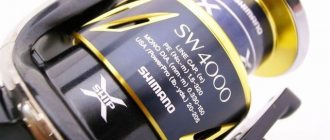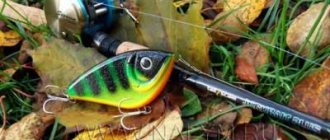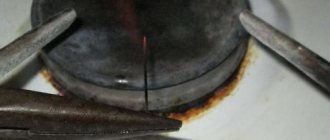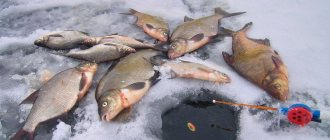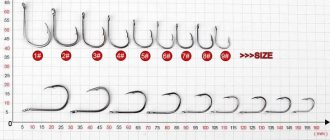If you try to understand this concept, it is the amplitude and speed of the rod tip returning to its original position when casting. Depending on the conditions and fishing method, the rod is selected with the appropriate action.
You shouldn’t be surprised if a fishing tackle consultant in a store interprets the concept differently, in his own words. After all, there are so many fishermen, so many opinions. In the article we will analyze what a system is, what types exist, their differences, nuances, advantages of using them for different types of fishing.
What types of them exist?
There are 4 key types. But some manufacturers also provide more average, intermediate options. Let's consider only the main types for now.
Extra-Fast
This spinning rod is tough. The cast is performed with a sharp movement, quickly and accurately. At the same time, the tip bends by 20–30 cm. All vibrations and jerks carried out by the fish are transmitted to the fisherman’s hand.
A spinning rod with a very fast action is recommended for use on coastline areas with tall trees, a lot of bushes and vegetation. Excellent for twitching fishing.
Fast
Not so rigid tackle, but still suitable for fishing in difficult conditions. And not only from the shore, but also from a boat, when there is no way to swing well. The disadvantage is that you can only make accurate casts at short distances. For long distances you will have to purchase a rod with a slow action.
Among the advantages of fast construction:
- Excellent sensitivity. The tip of the spinning rod signals even weak bites. The fisherman will be able to recognize that the bait has caught on an obstacle or hit the bottom.
- Ensures good cutting performance and a minimum of derailments.
- A balance is achieved between casting distance and control over the bait.
It is suitable for twitching fishing using baits:
- wobblers such as cranks;
- poppers;
- spinner spinners;
- vibrotails, worms.
It is also allowed for ultralight fishing. And if the test allows, then it can be used for heavy baits.
Medium, Moderate, Regular
Very similar to fast. But the tip has a greater bending amplitude. Designed for fishing from the shore. Allows you to make precise long casts. Has resistance to mechanical loads.
Used for jig fishing with the following baits:
- rattlins;
- shads;
- cranks;
- vibrators;
- Spinner spinners.
The medium action maintains sufficient bite sensitivity.
Slow
The working part of the rod bends along its entire length. Great for long casts. Works well with oscillating, spinning spoons and other lures. Resistant to heavy loads. Therefore, even from a long distance you can easily catch a large trophy. It is absolutely not suitable for jig fishing or the use of jackerbaits.
Rod parameters and their characteristics, depending on the material of manufacture
Forms from well-known manufacturers, as a rule, are marked with the material from which it is made:
- FIBERGLASS. These rods are made of fiberglass. This is the heaviest, but durable and inexpensive material used in the production of modern spinning rods.
- GRAPHITE. These forms are made from carbon fiber. This is the lightest, most durable, but much more expensive material.
- COMPOSITE. This means that this blank is made on the basis of a composite material that combines the advantages of the two above materials, but they are not as light as carbon fiber blanks and belong to the middle price category.
Gone is the era of bamboo poles, now the angler is given a choice of blanks made of fiberglass composite or plastic, and each of them has its own disadvantages and advantages.
Fiberglass fishing rods are very popular among fishermen, since the cost of such fishing rods is relatively low, and they do not require special care during operation. Since their strength is almost not affected by microcracks that they receive during transportation.
And here's what you need to know: A catchable lure for perch in winter
Important parameters of such fishing rods are their good flexibility and ability to withstand heavy loads. Unfortunately, this comes at the expense of sensitivity, and they also weigh more compared to similar sized carbon fiber and composite rods.
Carbon (graphite, carbon fiber) fishing rods are marked Carbon. It is believed that fishing rods made from this material are more modern and better suited for professional fishing. The quality characteristics of the rod are its lightness, fairly high sensitivity and good strength.
Carbon fishing rods differ depending on the graphite content module, which has values in the range IM-1 - IM-10 (there are fishing rods with other indicators, for example GL2, IMX); the marking of the graphite module must be presented on the form.
Rods with a low modulus of graphite content 1,2,3,4 are not so fragile, quite strong, soft and elastic, but they are significantly inferior when a sharp hook is needed. But rods that have a high modulus index are more rigid and sensitive, and they are good to use for casting over long distances, as well as for fishing at dusk, since you can feel the movement of the bait with your hand.
True, when using them, you should take care of the safety of the rod: transport it in a tube and avoid hitting rocks. It is also worth remembering that the rod conducts current, so it is better not to pick it up during a thunderstorm, and you should be careful near live parts of the machine and electrical wires.
The quality parameters of a rod made of bi-spiral carbon are very high; these blanks have good strength and ductility, without losing sensitivity.
relative affordability compared to carbon rods;
good casting range;
moderate hardness and good strength.
Which type is considered universal and optimal?
The exact choice is influenced by the type and size of the predatory fish. Since each predator has a different jerking force, the rod must not only withstand them, but also be convenient to use.
An extremely fast action is absolutely not suitable for large trophies, since a large fish can easily damage or break the form. And fishing with a strong bend in the tip can hardly be called successful.
Pike is known to fishermen for its sharp teeth, so to catch it you need to take a hard spinning rod. The material is preferable to carbon. In order for the pike to get caught on the hook and be fixed on it, fishermen perform a jerking retrieve with sharp hooks.
Which spinning rod system to choose?
Before choosing a spinning rod, you should decide what kind of fish you want to catch. The fact is that different types of fish have their own characteristics and what is good for catching one species may not be suitable for another.
For example, if we are talking about pike fishing, it is recommended to choose a hard spinning rod, preferably carbon, with average IM indicators. The reason is that the pike has a bony mouth and the chance that the hook will catch on something there on its own is extremely small. At the same time, you should not stop at Fast and Very Fast formation, since pike is too heavy a fish for such a formation. Again, it is difficult to pull such a frisky predator towards you when the tackle bends into an arc. So, it all depends on the fish.
Fast type for twitch and jig
A spinning rod made of carbon fiber or carbon fiber with a hard and loud working part is an excellent option for fishing with twitch or jig. Baits of medium weight or even heavy are allowed. But the fast action has a significant drawback - during a hook or jerk, the predator cuts its lip and comes off the hook when fishing. This often applies to pike.
To avoid such situations, experienced fishermen recommend replacing a regular single hook with a double or tee. In addition, when fishing, the angler’s technique is also important. It should help the rod, and not let the process take its course.
Step-by-step fishing looks like this:
- The tackle is in the hand and held with the hand. There should be no emphasis on the forearm.
- When a sharp jerk is heard, we work with the friction clutch with our hand, directing the rod in the direction of the jerk. When the jerk weakens, we direct the tackle to the top.
Another disadvantage of hard spinning rods is the wiring. When jig fishing, predators are not always interested in sudden detonations of the bait from the bottom. Therefore, if the situation requires it, the technique is changed in favor of another type or a successful combination of several types is selected.
What does spinning system mean?
The structure of a spinning rod is a characteristic that determines its rigidity and ability to bend under weight. How to determine the structure of a spinning rod? It is determined as follows: A weight twice the maximum recommended for bait is attached to the rod, after which the blank, under its weight, bends, taking a certain shape. That is, if the maximum test weight of the bait is 7-30 g, then you should hang a load weighing 60 g, after which the rod will bend. This method is also suitable for determining the structure of a spinning rod at home.
Accordingly, depending on the adopted form, the structure is determined. It depends on this what kind of fish it is suitable for catching and in what conditions.
Expert opinion
Knipovich Nikolai Mikhailovich
Zoologist, hydrobiologist. I am interested in fishing at a professional level.
Important! In stores it is not always possible to check the system in this way. But don’t worry, since all the technical characteristics are always indicated on the rod itself.
According to the existing rules, the classification of spinning rods by structure is divided into four types:
- Very fast, also known as Extra Fast (EF). When loaded, it bends in the upper quarter of the form.
- Fast, also known as Fast (F). The upper third is bent.
- Average, Moderate (M). Under load, half of the rod bends.
- Slow, aka Slow (S) - The bend is visible along almost the entire length of the rod.

More about slow build
Ultralight fishing with thin line and light bait is becoming increasingly popular. It is believed that a flexible tip tackle has a limited range of action due to its speed. But a well-functioning blank with a slow action expands the range of possibilities for the fisherman, allowing him to make long casts with light baits to a decent depth. Most of the landings are successful. The number of departures is reduced.
Such a soft rod allows you to respond well to fish jerks. A thin hook is less likely to harm the fish. Thin braid will not be damaged either. When the gear is quickly set up, twitching fishing with a wobbler, with a sharp detonation from the bottom of the reservoir, is successful. Any predator reacts to such harsh jerks with great interest. But even with a soft rod you can carry out similar manipulations; it only takes a little training.
The rod should be at an obtuse angle relative to the thread. When the fisherman makes a jerk, the tip will remain motionless, and the middle part of the tackle will have to work. The thread is loosened, the tackle is held in the direction of the bait and a sharp acceleration is made. Until the thread goes into tension (jerk), the spinning rod has time to accelerate. That is, the main load during a jerk is taken not by the tip, but by the powerful part of the rod. Fish hooking is also carried out according to this principle.
Line test and power.
Don’t forget about the maximum line test, which reflects the power of the spinning rod. It is usually indicated in Lb (1Lb = 0.45359237 kg).
If you put a cord or fishing line with a higher breaking load than indicated on the spinning rod, then there is a chance of breaking the form under load (in this case, the fishing line is a limiter against breakage). There are also exceptions when the fishing line is specially set with an overestimated test, for example, in places with a large number of hooks where it is often necessary to save expensive baits.
Ultra-Light (UL) – ultra-light spinning rods whose test can start from 0.5g and end at about 5-6g and are suitable for working with thin fishing lines and cords up to 4-5Lb
Light (L) – starts from 0.5-1g and averages up to 8g
Here's what you need to know: Spinning fly reel
Medium-Light (ML) – from 3-5g to 18-20g
Medium (M) – spinning rods from 5-6g to 20-25g, as a rule, the line test does not exceed 16Lb
Heavy (H) – can reach up to 40 – 60g
But you should understand that the power of a spinning rod does not always depend directly on the test. Test and power are different characteristics and may vary between manufacturers.
